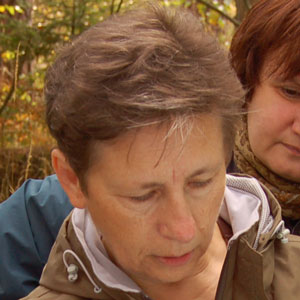Prof. dr hab. Małgorzata Latałowa
 Pracownia Paleoekologii i Archeobotaniki
Pracownia Paleoekologii i Archeobotaniki
Katedra Ekologii Roślin
Uniwersytet Gdański
ul. Wita Stwosza 59
80-308 Gdańsk
tel./fax: 58 523 61 14
Moje zainteresowania naukowe koncentrują się na trzech interdyscyplinarnych dziedzinach – paleoekologii czwartorzędu, archeobotanice i aerobiologii. Od ponad 20 lat regularnie współpracuję z archeologami odtwarzając warunki środowiskowe dawnego osadnictwa, opracowując dane dotyczące roślin użytkowych oraz rozwoju synantropijnej flory i roślinności. W ostatnich latach, współpraca z szeregiem zespołów archeologicznych umożliwiła szeroko zakrojone badania archeobotaniczne na terenie historycznego Gdańska.
Od początku swojej pracy naukowej współpracowałam w ramach międzynarodowych programów i projektów. W latach 1978-1988 byłam wykonawcą w International GeologicalCorrelationProgramme IGCP-158 B – jestem współautorką kończącej ten projekt syntezy dla Polski (1966). W latach 1991-1995 byłam członkiem grupy roboczej Palaeoclimate and Man współfinansowanego przez EuropeanScience Foundation. Od 1996 r. współpracuje w ramach European Pollen Monitoring Programme (PMP) wspieranego przez ESF oraz INQUA – jestem współautorką pierwszego przewodnika metodycznego dla tego programu. W ostatnich latach byłam partnerem w międzynarodowym projekcie EU FOSSILVA (Dynamics of forest tree biodiversity: linking genetic, palaeogenetic and plant historical approaches),w Hansa-Network Project (Medieval Food Traditions in Northern Europe) finansowanym przez Council of Nordic Ministers, polsko-francuskim programie Polonium oraz finansowanych przez NorFAThe Pollen-Landscape Calibration Network i LANDCLIM.
Obecnie jestem kierownikiem Pracowni Paleoekologii i Archeobotaniki Uniwersytetu Gdańskiego, przewodniczącą Rady Redakcyjnej serii wydawniczej Środowisko-Człowiek-Cywilizacja, członkiem Ząrządu Polskiego Stowarzyszenia Archeologii Środowiskowej, Polskiego Towarzystwa Botanicznego, International Federation of Palynological Societies, Sekcji Geologicznej Komitetu Badań Morza PAN, Komisji Paleogeografii PAU i Gdańskiego Towarzystwa Naukowego.
Wybrane publikacje dotyczące tematyki Projektu
- Postglacial vegetational changes in the eastern Baltic coastal zone of Poland, Acta Palaeobotanica, 22(2), 1982, s. 179-249.
- The Late-glacial and early Holocene history of the vegetation in the Wolbrom area (Silesian-Cracovian Upland - S. Poland), (w:) G. Lang, Ch. Schluchter (red.), Lake, mire and river environments during the last 15.000 years, Balkema, Rotterdam 1988, s. 9-22.
- Man and vegetation in the pollen diagrams from Wolin Island (NW Poland), Acta Palaeobotanica, 32(1), 1992, s. 123-249.
- Poland, (w:) B.E. Berglund, H.J.B. Birks, M. Ralska-Jasiewiczowa, H. Wright (red.), Palaeoecological Events During the Last 15,000 years. Regional Syntheses of Palaeoecological Studies in Lakes and Mires in Europe, Chichester, 1996 s. 403-472, (współautorstwo: M. Ralska-Jasiewiczowa).
- Palaeoecological reconstruction of the environmental conditions and economy in early medieval Wolin – against a background of the Holocene history of the landscape, Acta Palaeobotanica 39(2), 1999, s. 183-271.
- Perception and viewsheds: are they mutually inclusive?, (w:) G. Lock (red.), Beyond the Map, Amsterdam-Berlin-Oxford-Tokyo-Washington DC, 2000, s. 28-48 (współautorstwo: A Tschan, W. Rączkkowski).
- Archaeobotanical samples from non-specific urban contexts as a tool for reconstructing environmental conditions (examples from Elbląg and Kołobrzeg, northern Poland), Vegetation History and Archaeobotany, 12, 2003, s. 93-104 (współautorstwo: M. Badura, J. Jarosińska).
- Late Glacial and Holocene history of vegetation in Poland based on isopollen maps, M. Ralska-Jasiewiczowa, K. Wasylikowa, E. Madeyska. H.E. Jr. Wright, Ch. Turner (red.), W. Szafer Institute of Botany, Polish Academy of Sciences, 2004 Kraków.
- The Allerød/Younger Dryas transition in Wolin Island, northwest Poland, as reflected by pollen, macrofossils, and chemical content of an organic layer separating two aeolian series, Vegetation History and Archaeobotany 15, 2006, s. 321-331 (współautorstwo: K. Borówka).
- A new scenario for the Quaternary history of European beech populations: palaeobotanical evidence and genetic consequences, New Phytologist 171, 2006, s. 199-221 (współautorstwo: D. Magri, G. G. Vendramin, B. Comps, I. Dupanloup, T. Geburek, D. Gomory, T. Litt, L. Paule, J.M. Roure, I. Tantau, W.O. van der Knaap, R.J. Petit, J-L. de Beaulieu).
- Late Quaternary expansion of Norway spruce Piceaabies (L.) Karst in Europe according to pollen data, Quaternary Science Reviews 25, 2006, s. 2780-2805 (współautorstwo: W.O. van der Knaap).
- Useful plants in medieval and post-medieval archaeobotanical materials from the Hanseatic towns of northern Poland (Kołobrzeg, Gdańsk and Elbląg), (w:) S. Karg (red.), Medieval Food Traditions in Northern Europe, PNM Studies in Archaeology and History 12, 2007, s. 39-72 (współautorstwo: M. Badura, J. Jarosińska, J. Święta-Musznicka).
- Genetic consequences of glacial survival and postglacial colonization in Norway spruce: combined analysis of mitochondrial DNA and fossil pollen, Molecular Ecology 17, 2008, s. 4134-4150 (współautorstwo: M.M. Tollesfrud, R. Kissling, F. Gugerli, O. Johnsen, T. Skroppa, R. Cheddadi, W.O. van der Knaap, R. Terhuerne Berson, T. Litt, T. Geburek, C. Brochmann, C. Sperisen).
- Salvinianatansin medieval wetland deposits in Gdańsk, northern Poland: evidence for the early medieval climate warming, Journal of Paleolimnology 45(3), 2011, s. 369-383 (współautorstwo: J. Święta-Musznicka, J. Szmeja, M. Badura).
- Quantitative reconstructions of changes in regional openness in north-central Europe reveal new insights into old questions, Quaternary Science Reviews 47, 2012, s. 131-149 (współautorstwo: A.B. Nielsen, H-J. Beug, S-H. Chen, J. Christiansen, W. Dörfler, E. Endtmann,S. Jahns, P. de Klerk, N. Kühl, BV. Odgaard, P. Rasmussen, JR. Stockholm, R. Voigt, J. Wiethold, S. Wolters).


